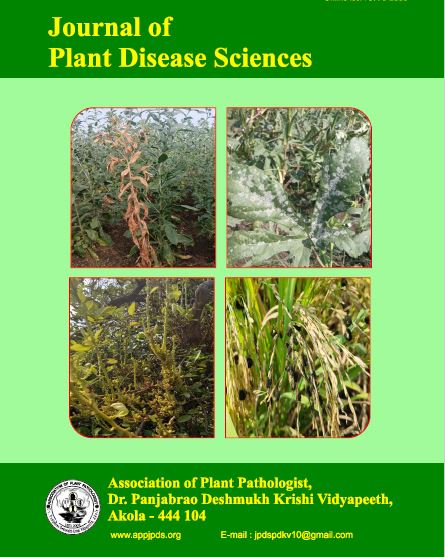FIELD EVALUATION OF VARIOUS CHEMICALS AND BIOAGENT AGAINST BACTERIAL BLIGHT OF DESI COTTON
DOI:
https://doi.org/10.48165/jpds.2024.1901.10Keywords:
Desi Cotton, Bioagent, Chemicals, Xanthomonas, axonopodis malvacearum, pv.Abstract
Bacterial blight cause yieldlossesincotton cropworldwide. Lossesare lesswhen only leaves are infected but when stem lesions are formed, the losses may be high as upto 90%. The experiment was planned to evaluate the twelve spray treatments viz. 10 chemicals, one bioagent and one untreated control in natural field conditions against Xanthomonas axonopodis pv. malvacearum causing bacterial blight of cotton in Desi variety. First Spray wasgiven at first apperance of disease and subsequent twosprays were given at 15 days interval. Observations on disease incidence (PI) and disease severity (PDI) were recorded before one day of each spray.Amongsthe chemicals and bioagent tested the results obtained after third spray indicated that significantly lowest disease incidence of 20.84 % was recorded by the treatment streptocycline + copper oxychloride followed by the treatment streptocycline + carbendazim (20.92%), streptocycline + copper hydroxide (20.96 %), bordeaux mixture (21.35 %), but all four treatmentsfoundatpar in successionasagainst the unsprayed control 51.18 per cent (PI) and lowest disease severity of 10.22 % was recorded by the treatment streptocycline + Copper oxychloride followed by the treatmentstreptocycline + carbendazim (11.33 %), streptocycline + copper hydroxide (13.00 %), streptocycline (13.45 %).
References
Anonymous, 2018 : Current Cotton Scenario, the Cotton Corporationof India (CCI), Mumbai.
Chattannavar SN, G.N. Hosagoudar and S. A. Ashtaputre : Chemical and biological management of major foliar diseases of cotton. Global Journal of Science Frontier Research, 2013;13(1):1-4.
Govindappa, Hosagoudar and S.N.Chattannavar, 2008: Chemical and biological control of foliar diseases of cotton. J. Cotton Res. Dev. 22(2): 225- 228.
Hillocks, R. J., 1992 : Fungal diseases of the leaf. In Cotton Diseases, CABInternl. : 191-238.
Ingole, O. V., B. R. Patil and R. M. Gade, 2011 : Chemical and biological management o fbacterial blight of cotton caused by Xanthomonas axonopodis pv. malvacearum. J. Cotton Res. Dev., 25(1): 88-90.
Ingole, O. V., M. A. Unhale, P. W. Nemade and B. R. Patil, 2015 : Estimation of avoidable seed cotton losses caused by bacterial blight and chemical management of cotton. J. Cotton Res. Dev., 29(1): 177-180.
Jagtap, G. P., A. M. Jangam and U. Dey, 2012: Management of bacterial blight of cotton caused by Xanthomonas axonopodis pv. malvacearum. Scientific Journalof Microbiology, 1(1): 10-18.
Jat, A., P. S. Shekhawat and K. K. Saini, 2022 : Management of bacterial blight of clusterbean caused by Xanthomonas axonopodis pv. cyamopsidis under field conditions. Legume Research, 1-6.
Kumar, R., M. R. Shamarao, Jahagirdar, S. T. Yenjerappa and H. B. Patil, 2006 : Epidemiology and management of bacterial blight of pomegranate caused by Xanthomonas
axonopodis pv. punicae. ISHS Acta Horticulture.
Kumhar, D. R., A. K. Meena and P. N. Meena, 2018 : Efficacy of different management modules against bacterial blightof clusterbean under epiphytotic conditions. J. Pharmacogn. Phytochem, 7(3): 1505-1509.

